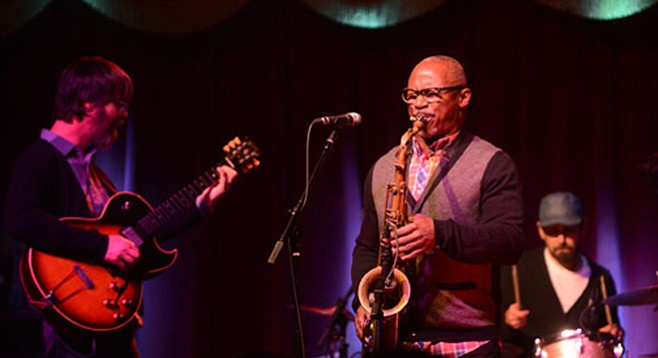 Facebook
Facebook
 X
X
 Instagram
Instagram
 TikTok
TikTok
 Youtube
Youtube

Doubtless that anybody in the Green Circle Bar in San Diego in 1993 heard a future Rolling Stone when the house deejay introduced his latest project, a collaborative between the turntables and live music he called the Greyboy Allstars. But even then, hometown saxist/flutist/vocalist Karl Denson (he would join the Stones’ touring band a couple of decades into the future) had already found his way onto the national stage with Lenny Kravitz. Andreas Stevens, who went by DJ Greyboy, had connected with Denson earlier and liked the energy. Together they amassed a band: drummer Zak Najor (eventually replaced by Aaron Redfield), bassist Chris Stillwell, Elgin Park on guitar, and keyboardist Robert Walter made a groove-based sound that fit right in with the whole acid-jazz scene going on then. Soon after, they released DJ Greyboy’s breakout record, Freestylin’.
Pop-music critics warehoused the Allstars as a jazz group. They are no such animal. Rather, the band dug deep into a genre for which they named their first album. That was West Coast Boogaloo, featuring the anointing presence of James Brown’s ’bone player, Fred Wesley. Otherwise, boogaloo doesn’t get played much anymore. The soul/funk/R&B vibe is essentially Latin music, which is to say Afro-Cuban in origin. Dance music, which jazz is not and never will be.
Andreas Stevens, a record-label proprietor, still lives in San Diego, and although he no longer gigs with the Greyboy Allstars, he is said to have a hand in their creative direction. Far from prolific, the Allstars are known for vast creative stretches between releases; it took them a decade to discharge 2007’s What Happened to Television after the triumph of A Town Called Earth. Greyboy Allstars’ first new music in six years was Inland Emperor, a full album they released in 2013. Is there another CD or two in this band’s future? The likely answer is yes — but don’t hold your breath.


Doubtless that anybody in the Green Circle Bar in San Diego in 1993 heard a future Rolling Stone when the house deejay introduced his latest project, a collaborative between the turntables and live music he called the Greyboy Allstars. But even then, hometown saxist/flutist/vocalist Karl Denson (he would join the Stones’ touring band a couple of decades into the future) had already found his way onto the national stage with Lenny Kravitz. Andreas Stevens, who went by DJ Greyboy, had connected with Denson earlier and liked the energy. Together they amassed a band: drummer Zak Najor (eventually replaced by Aaron Redfield), bassist Chris Stillwell, Elgin Park on guitar, and keyboardist Robert Walter made a groove-based sound that fit right in with the whole acid-jazz scene going on then. Soon after, they released DJ Greyboy’s breakout record, Freestylin’.
Pop-music critics warehoused the Allstars as a jazz group. They are no such animal. Rather, the band dug deep into a genre for which they named their first album. That was West Coast Boogaloo, featuring the anointing presence of James Brown’s ’bone player, Fred Wesley. Otherwise, boogaloo doesn’t get played much anymore. The soul/funk/R&B vibe is essentially Latin music, which is to say Afro-Cuban in origin. Dance music, which jazz is not and never will be.
Andreas Stevens, a record-label proprietor, still lives in San Diego, and although he no longer gigs with the Greyboy Allstars, he is said to have a hand in their creative direction. Far from prolific, the Allstars are known for vast creative stretches between releases; it took them a decade to discharge 2007’s What Happened to Television after the triumph of A Town Called Earth. Greyboy Allstars’ first new music in six years was Inland Emperor, a full album they released in 2013. Is there another CD or two in this band’s future? The likely answer is yes — but don’t hold your breath.
Comments